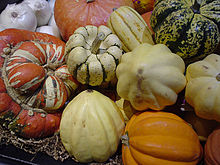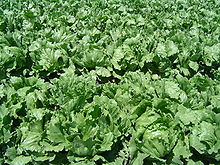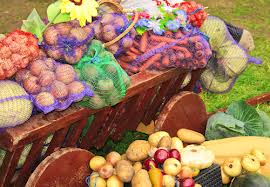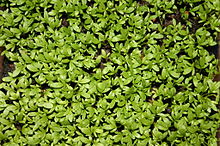History of Vegetable & Fruits

First Thanksgiving Meal
For many Americans, the Thanksgiving meal includes seasonal dishes such as roast turkey with stuffing, cranberry sauce, mashed potatoes and pumpkin pie. The holiday feast dates back to November 1621, when the newly arrived Pilgrims and the Wampanoag Indians gathered at Plymouth for an autumn harvest celebration, an event regarded as America’s “first Thanksgiving.” But what was really on the menu at the famous banquet, and which of today’s time-honored favorites didn’t earn a place at the table until later in the holiday’s 400-year history?
 Food origins play a role in nutrition and sustainability as foods with common geological origins have a greater tendency to survive and be valued by the locals. Importance in food therapy is also involved, as allergies to certain foods can be attributed to race. In this way it’s a part of the local food movement. An example would be lactose intolerance among Polynesians and Native Americans who were not accustomed to breeding cattle as much as Europeans. Combined with seasonal cooking, food origins can be used in predicting the tendency of ingredients to work well together, like wine and cheese or rice and tofu. Some foods have a tendency to develop with predominant civilizations like Chinese herbs in Asia and fertile crescent agriculture in the Middle East. Many culinary fruits have global origins, especially berries, more so than vegetables. Fowl are also common on many different continents, like geese and ducks. Different variations of vegetables can be found on different continents, like yams in Africa and potatoes in South America. Another example would be walnuts in Europe and pecans in North America.
Food origins play a role in nutrition and sustainability as foods with common geological origins have a greater tendency to survive and be valued by the locals. Importance in food therapy is also involved, as allergies to certain foods can be attributed to race. In this way it’s a part of the local food movement. An example would be lactose intolerance among Polynesians and Native Americans who were not accustomed to breeding cattle as much as Europeans. Combined with seasonal cooking, food origins can be used in predicting the tendency of ingredients to work well together, like wine and cheese or rice and tofu. Some foods have a tendency to develop with predominant civilizations like Chinese herbs in Asia and fertile crescent agriculture in the Middle East. Many culinary fruits have global origins, especially berries, more so than vegetables. Fowl are also common on many different continents, like geese and ducks. Different variations of vegetables can be found on different continents, like yams in Africa and potatoes in South America. Another example would be walnuts in Europe and pecans in North America.
America
Various squashes such as Turban, Sweet Dumpling, Carnival, Gold Acorn, Delicata, Buttercup and Golden Nugget.
Corn, beans and squash were domesticated in Mesoamerica around 3500 BCE. Potatoesand manioc were domesticated in South America. In what is now the eastern United States, Native Americans domesticated sunflower, sumpweed and goosefoot around 2500 BCE.
Ancient American Crops
| Cereals | Maize (corn), maygrass, and little barley |
|---|---|
| Pseudocereals | Amaranth, quinoa, erect knotweed, sumpweed, and sunflowers |
| Pulses | Common beans, tepary beans, scarlet runner beans, lima beans, and |
| Fiber | Cotton, yucca, and agave |
| Roots and Tubers | Jicama, manioc (cassava), potatoes, sweet potatoes, sunchokes, oca, |
| Fruits | Tomatoes, chili peppers, avocados, cranberries, blueberries, huckleberries, cherimoyas,
papayas, pawpaws, passionfruit, pineapples, soursops and strawberries |
| Melons | Squashes |
| Meat and poultry | turkey, bison, muscovy ducks, dogs and guinea pigs |
| Nuts | Peanuts, black walnuts, shagbark hickory, pecans and hickory nuts |
| Other | Chocolate, Canna, tobacco, Chicle, rubber, maple syrup, birch syrup and vanilla |
This is a list of plants that have a culinary role as vegetables. “Vegetable” can be used in several senses, including culinary, botanical and legal. This list includes botanical fruits such as pumpkins, and does not include herbs, spices, cereals and mostculinary fruits and culinary nuts. Currently, edible fungi are not included on this list. Legal vegetables are defined for regulatory, tax and other purposes. Examples include tomatoes, which are a botanical berry, but a culinary vegetable for US tax purposes, and even tomato sauce as found on pizza, which is considered a vegetable for use in school lunches in the US.
Some culinary vegetables (like laver) are not even members of the plant kingdom, although mushrooms and other fungi are kept off the list for this reason.
Leafy and salad vegetables – Main article: List of leaf vegetables
 Iceberg lettuce field in Northern Santa Barbara County
Iceberg lettuce field in Northern Santa Barbara County
- Amaranth (Amaranthus cruentus)
- Arugula (Eruca sativa)
- Beet greens (Beta vulgaris subsp. vulgaris)
- Bok choy (白菜 Brassica rapa Chinensis group)
- Borage greens (Borago officinalis)
- Broccoli Rabe (Brassica rapa subsp. rapa)
- Brussels sprout (Brassica oleracea Gemmifera group)
- Cabbage (Brassica oleracea Capitata group)
- Catsear (Hypochaeris radicata)
- Celery (Apium graveolens)
- Celtuce (Lactuca sativa var. asparagina)
- Ceylon spinach (Basella alba)
- Chaya (Cnidoscolus aconitifolius subsp. aconitifolius)
- Chickweed (Stellaria)
- Chicory (Cichorium intybus)
- Chinese Mallow (Malva verticillata)
- Chrysanthemum leaves (Chrysanthemum coronarium)
- Collard greens (Brassica oleracea)
- Corn salad (Valerianella locusta)
- Cress (Lepidium sativum)
- Dandelion (Taraxacum officinale)
- Endive (Cichorium endivia)
- Fat hen (Chenopodium album)
- Fiddlehead (Pteridium aquilinum, Athyrium esculentum)
- Fluted pumpkin (Telfairia occidentalis)
- Garden Rocket (Eruca sativa)
- Golden samphire (Inula crithmoides)
- Good King Henry (Chenopodium bonus-henricus)
- Greater Plantain (Plantago major)
- Kai-lan (Gai Lan 芥蘭 Brassica rapa Alboglabra group)
- Kale (Brassica oleracea Acephala group)
- Komatsuna (Brassica rapa Pervidis or Komatsuna group)
- Kuka (Adansonia spp.)
- Lagos bologi (Talinum fruticosum)
- Lamb’s lettuce (Valerianella locusta)
- Land cress (Barbarea verna)
- Lettuce (Lactuca sativa)
- Lizard’s tail (Houttuynia cordata)
- Melokhia (Corchorus olitorius, Corchorus capsularis)
- Miner’s Lettuce
- Mizuna greens (Brassica rapa Nipposinica group)
- Mustard (Sinapis alba)
- Napa cabbage (Siu Choi 召菜 Brassica rapa Pekinensis group)
- New Zealand Spinach (Tetragonia tetragonioides)
- Orache (Atriplex hortensis)
- Pak choy (Bok Choy 白菜 Brassica rapa Chinensis group)
- Paracress (Acmella oleracea)
- Pea sprouts/leaves (Pisum sativum)
- Poke (Phytolacca americana)
- Radicchio (Cichorium intybus)
- Samphire (Crithmum maritimum)
- San Choy (潺菜 – broad, green leaves)
- Sculpit/Stridolo (Silene inflata) an Italian vegetable that’s considered to taste like a cross of arugula and cos lettuce
- Sea beet (Beta vulgaris subsp. maritima)
- Sea kale (Crambe maritima)
- Sierra Leone bologi (Crassocephalum spp.)
- Soko (Celosia argentea)
- Sorrel (Rumex acetosa)
- Spinach (Spinacia oleracea)
- Summer purslane (Portulaca oleracea)
- Swiss chard (Beta vulgaris subsp. cicla var. flavescens)
- Tatsoi (Brassica rapa Rosularis group)
- Turnip greens (Brassica rapa Rapifera group)
- Watercress (Nasturtium officinale)
- Water spinach (Ipomoea aquatica)
- Wheatgrass (Triticum aestivum)
- Winter purslane (Claytonia perfoliata)
- Yarrow (Achillea millefolium)
- Yao Choy (Yu Choy, Rape, 油菜 Brassica napus)





